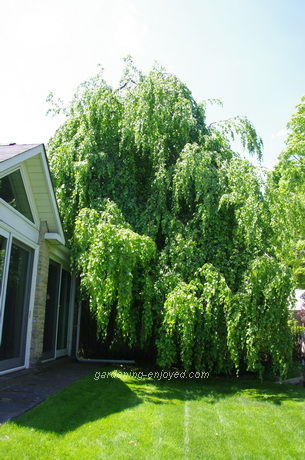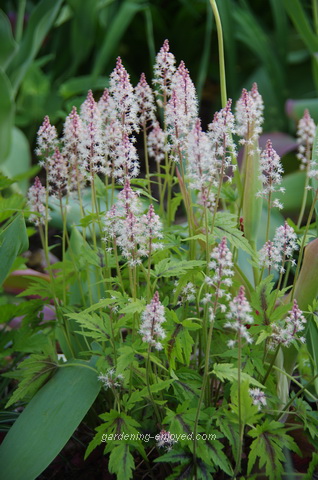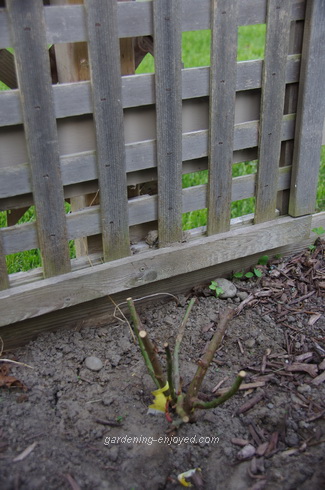| Back to Back Issues Page |
 |
|
Dallying In The Dirt, Issue #219--- The Albrighton Rambler is eyeing my trellis May 24, 2015 |

I couldn’t write on Friday morning because I was busy uncovering all the tender plants that I had gambled with. We did get that late light frost. The grass was nicely white as was the roof of the garage. My reluctance to plant before the 24th of May actually looks like prudence not procrastination. The few things that I did have out don’t seem to have suffered much but they were either up off the ground or protected over night. The Asparagus continues to feed us almost every day and I’m accumulating a nice bag full in the fridge that will become Asparagus soup sometime in the next few days. I spent Thursday morning touring some wonderful gardens. It was the media preview of Through the Garden Gate the Toronto Botanical Garden’s annual garden tour. This year it wanders through 19 gardens in the Lawrence Park
district. They have tried to choose many gardens that are developed and maintained by their owners and that leads to a great diversity of styles. For a plant addict like me it also lets me see some amazing plant specimens that might not be seen in commercially created gardens. The entrance to one back yard, through the draping branches a large weeping Beech, was like the passage way to a secret garden. The tour is on the 13th and 14th of June and is a great way to peek into the gardens around some fascinating architecture. It’s also the Toronto Botanical Gardens major fund raising activity for the year and they are a cause well worth supporting.  Tiarella is a native woodland perennial with delicate sprays of flowers standing high above the foliage in the late spring. In the last few years it has been discovered by the plant breeders and there is now an increasing number of varieties available. One of their best features is their tolerance for shade. I planted one under my Harlequin Maple last year when I was making the new path there. It is now in full bloom and my inability to keep decent records is irritating me as I cannot determine which variety it is. It’s a great foil for Hosta in the shade garden, where it’s light, patterned leaves and delicate spring flowers provide a great contrast to the heavy leaves and late summer flowers of the Hosta. Some of the varieties will spread by underground runners to make a reasonable ground cover and others maintain a clumping nature. Read labels to make sure that you choose a variety that does what
you want it to. They are all happy in the shade and some prefer moist woodland soils while others are quite tolerant of dry shade.
Tiarella is a native woodland perennial with delicate sprays of flowers standing high above the foliage in the late spring. In the last few years it has been discovered by the plant breeders and there is now an increasing number of varieties available. One of their best features is their tolerance for shade. I planted one under my Harlequin Maple last year when I was making the new path there. It is now in full bloom and my inability to keep decent records is irritating me as I cannot determine which variety it is. It’s a great foil for Hosta in the shade garden, where it’s light, patterned leaves and delicate spring flowers provide a great contrast to the heavy leaves and late summer flowers of the Hosta. Some of the varieties will spread by underground runners to make a reasonable ground cover and others maintain a clumping nature. Read labels to make sure that you choose a variety that does what
you want it to. They are all happy in the shade and some prefer moist woodland soils while others are quite tolerant of dry shade. Now it’s time to answer a few of my reader’s questions. Don’t forget to check the front page of the Website for frequent short ideas for current gardening activities. Donna Asks? I have a couple of the older peonies that are outgrowing the supports I have. What do you recommend to use on the big peonies? I was thinking chicken wire. Thanks and enjoy your emails. |
| Back to Back Issues Page |
 Earlier in the week a wonderful box arrived. It contained 3 rather dead looking sets of branches. They were anything but dead but dormant bare root Roses are just a collection of brown roots and green branches. These were my new David Austin Roses. New Roses were particularly welcome this year as the very cold winter had taken its toll on some of my old favourites. A new variety they are introducing this year is the
Earlier in the week a wonderful box arrived. It contained 3 rather dead looking sets of branches. They were anything but dead but dormant bare root Roses are just a collection of brown roots and green branches. These were my new David Austin Roses. New Roses were particularly welcome this year as the very cold winter had taken its toll on some of my old favourites. A new variety they are introducing this year is the